Hi there, pet lovers! 🐠
The guppy (Poecilia reticulata) is arguably the quintessential freshwater aquarium fish, and its reputation is well-earned. These small, vibrant fish have been the gateway into the aquarium hobby for generations of fish keepers. Their dazzling colors, fascinating behaviors, and remarkable ease of breeding make them a perpetual favorite. In this detailed review, we will dive deep into everything you need to know about keeping guppies, from their origins and care requirements to their breeding habits and common health concerns. Whether you are a complete beginner setting up your first tank or a seasoned aquarist looking for a pop of color, this guide will provide you with all the information for a successful guppy-keeping experience.
Overview
Guppies are small, live-bearing fish native to South America. They are celebrated for their incredible color variations and energetic personalities. Through extensive selective breeding, the domestic guppies available today are a far cry from their wild ancestors, showcasing a breathtaking array of colors, patterns, and tail shapes. Here’s a quick summary of what makes them so popular:
- Handling and Temperament: Peaceful, active, and non-aggressive, but not a fish to be handled.
- Care and Maintenance: Generally low-maintenance but require stable, clean water conditions.
- Health and Durability: Hardy, but modern strains can be susceptible to disease if not cared for properly.
- Availability: Extremely widely available and affordable.
- Cost: Very inexpensive to purchase, with low ongoing costs.
- Overall: A fantastic, rewarding choice for community aquariums and beginner hobbyists.

Why Choose a Guppy?
Guppies are the perfect starter fish for anyone new to the aquarium hobby. Their hardiness allows them to tolerate common beginner mistakes, while their constant activity and brilliant colors provide endless entertainment. They do not require a massive tank, making them ideal for apartments, dorm rooms, or offices. Furthermore, their prolific breeding habits offer a unique and educational window into the circle of life, allowing hobbyists to witness the entire process from birth to adulthood. For the experienced breeder, the challenge of developing new and unique strains provides a deeply engaging and creative pursuit.
Handling and Temperament
It is crucial to understand that guppies are not “handled” in the traditional sense like a reptile or mammal. They are delicate, aquatic creatures that should never be removed from the water. Their temperament, however, is observed entirely through their interactions within the aquarium.
A Peaceful Community Fish
Guppies are renowned for their peaceful and social nature. They are schooling fish, which means they feel most secure and display their best colors when kept in groups. We recommend a minimum of five or six guppies, with a ratio of one male to two or three females to prevent any single female from being overworked by a male’s constant breeding attentions. They spend their days actively swimming in all levels of the tank, constantly exploring plants and decorations.
Ideal Tank Mates
Choosing the right tank mates is critical. The question is not whether guppies will bother other fish, but whether other fish will bother your guppies. Their long, flowing fins can be an irresistible target for fin-nippers.
- Excellent Choices: Other small, peaceful community fish are ideal. These include Corydoras catfish, small Tetra species (Neon Tetras, Ember Tetras), peaceful Rasboras, Dwarf Gouramis, and other livebearers like Endlers. Invertebrates like Mystery Snails and Neocaridina Shrimp also make excellent companions.
- Poor Choices: Avoid large or aggressive fish like most Cichlids, Tiger Barbs, and larger species of Rainbowfish. Even fish often considered community fish, such as Serpae Tetras, can be a problem. Many hobbyists also ask about keeping guppies with Bettas; this is a risky combination, as a Betta may mistake a fancy guppy for a rival and attack its fins.
Personality and Activity
Guppies are not just colorful specks in the water; they have distinct personalities. You will notice some males are bold and spend their time displaying their fins to females, while others might be more shy. Their constant, darting movement and curiosity make them a dynamic and engaging focal point in any aquarium.
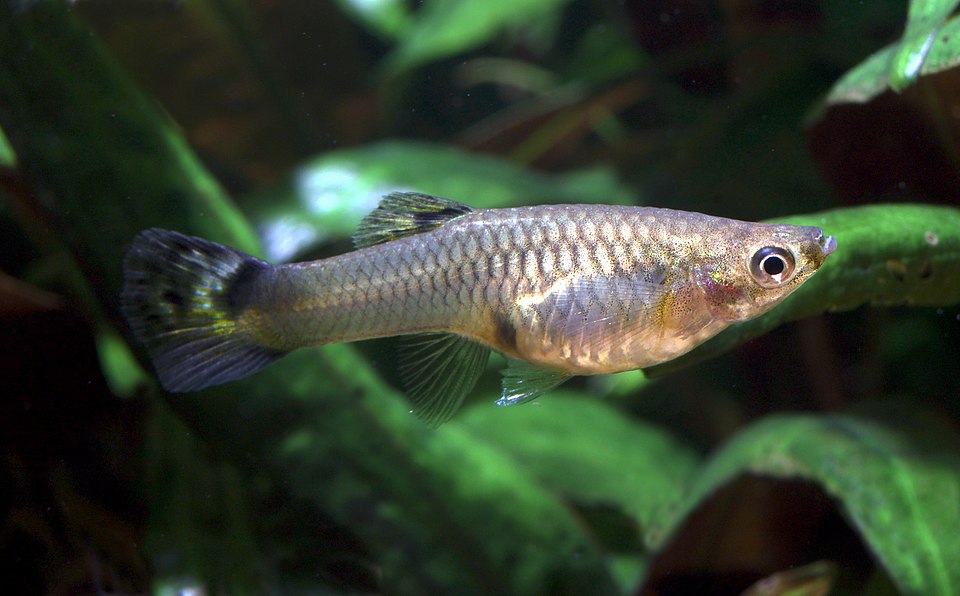
Care and Maintenance
While guppies are hardy, they thrive and show their best colors only when provided with excellent care. They are not a “set-it-and-forget-it” pet, and their well-being depends on a stable and clean environment.
Aquarium Setup
- Tank Size: A common misconception is that guppies can live in tiny bowls. This is incorrect and leads to poor health and shortened lifespans. For a small group of guppies, a 10-gallon aquarium is the recommended minimum. A 20-gallon long tank is even better, as it provides more horizontal swimming space. If you plan on breeding them, a larger tank is necessary to accommodate the growing population.
- Filtration: A gentle filter is essential. Guppies do not appreciate strong currents, which can exhaust them, especially males with large tails. Sponge filters are an excellent choice for guppy tanks as they provide effective biological filtration without a strong flow, and they are completely safe for newborn fry.
- Substrate and Decor: Guppies are not fussy about substrate. Gravel or sand both work well. The key is to provide plenty of live or silk plants, which offer security, reduce stress, and improve water quality. Plants like Java Moss, Hornwort, and Guppy Grass are fantastic as they provide crucial hiding spots for fry. Include caves and driftwood to create a natural and enriching environment.
Water Parameters
This is the most critical aspect of guppy care. While adaptable, they require stability.
- Temperature: As tropical fish, they require a heater. The ideal temperature range is 72-82°F (22-28°C). Warmer water accelerates their metabolism, leading to faster growth and breeding but a slightly shorter lifespan.
- pH and Hardness: Guppies prefer slightly alkaline, hard water. A pH between 7.0 and 7.8 and a general hardness (GH) above 8 dGH is ideal. Hard water is particularly important for proper bone and fin development.
- Water Quality: Like all fish, guppies are sensitive to ammonia and nitrite. These must always be at 0 ppm. Nitrates should be kept as low as possible, ideally below 20 ppm, through regular partial water changes. We recommend changing 25-30% of the water weekly to maintain pristine conditions.
Feeding
Guppies are omnivores with hearty appetites, but they have small mouths. A varied diet is the key to vibrant colors, strong immune systems, and high fertility.
- Staple Diet: A high-quality, micro-pellet or flake food formulated for tropical fish should be the base of their diet. Look for foods with natural color enhancers like spirulina.
- Variety is Key: To ensure optimal health, supplement their diet with live or frozen foods several times a week. They relish baby brine shrimp, daphnia, bloodworms, and mosquito larvae. These foods are packed with protein and are especially beneficial for conditioning breeding adults.
- Feeding Schedule: Feed small amounts two times a day. Offer only what they can consume within two minutes to avoid overfeeding, which pollutes the water.
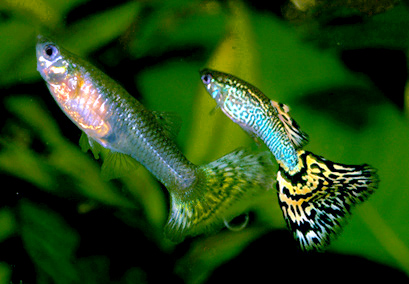
Health and Durability
The reputation of guppies as “bulletproof” has been somewhat diminished by modern mass-breeding practices. While still hardy, they can be more susceptible to health issues than their wild ancestors.
Common Health Issues
- Ich (White Spot Disease): This is one of the most common ailments. It presents as tiny white salt-like spots on the body and fins. It is often triggered by stress, such as sudden temperature changes. Consistently using a heater is the best prevention.
- Fin Rot: This bacterial infection causes the fins to appear ragged, torn, and discolored. It is almost always a sign of poor water quality. Improving tank hygiene is the first step to treatment.
- Fungal Infections: Cotton-like growths on the body can indicate a fungal issue, which also often stems from suboptimal conditions.
- Internal Parasites and “Wasting Disease”: A sunken belly and a thin body despite a good appetite can signal internal parasites. Quarantining new fish and using deworming medications when necessary can prevent this.
Preventative Care
The cornerstone of guppy health is prevention. A stable, clean tank with excellent filtration and a varied, nutritious diet will prevent the vast majority of health problems. We strongly advise quarantining all new fish in a separate tank for at least two to four weeks before introducing them to your main aquarium. This simple step can prevent the introduction of disease that could wipe out your entire collection.
Lifespan
The typical guppy lifespan is one to three years. Several factors influence this, including genetics, water temperature, and overall care. Warmer tanks tend to lead to faster metabolisms and slightly shorter lives, while cooler tanks within their ideal range can extend their lifespan.
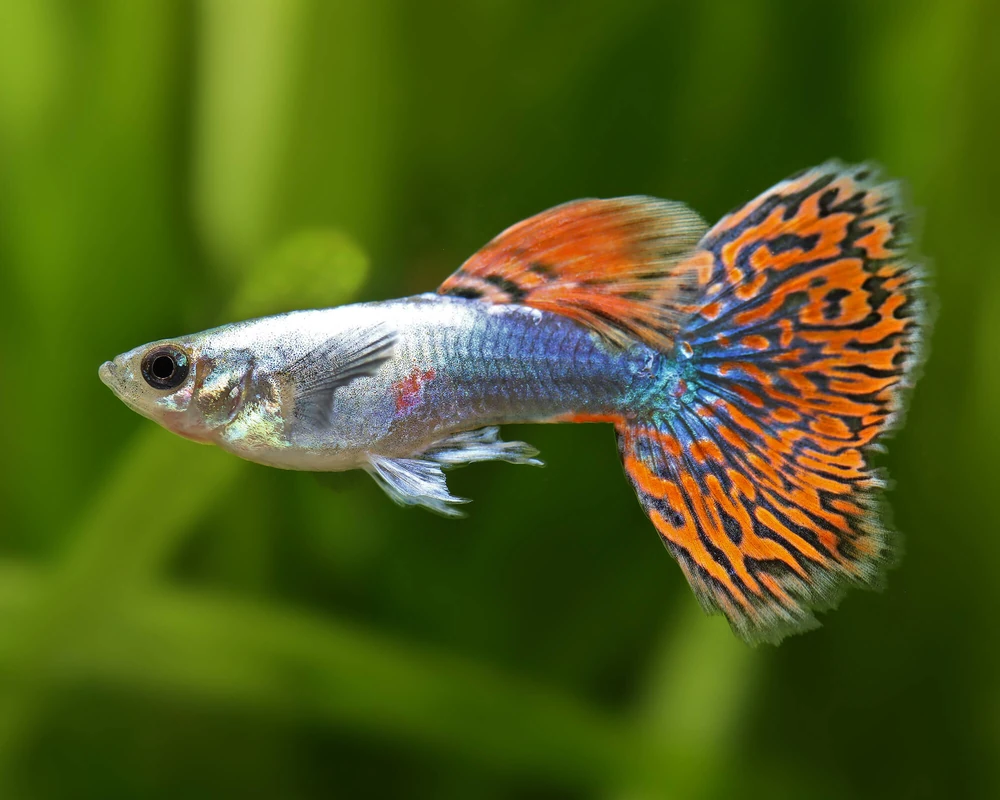
Availability and Cost
Guppies are one of the most accessible pets in the world.
Where to Buy
You can find guppies at virtually every local pet store, large chain pet retailers, and from countless online breeders and aquarium societies. For the most unique and high-quality strains, seeking out a dedicated breeder is your best bet. They often offer robust, line-bred fish with superior genetics compared to those from large-scale commercial farms.
Cost
- Guppy Price: The cost is highly variable. Common “feeder” or mixed-color guppies can cost as little as $3 to $5 per fish. However, high-end, specialty strains with unique colors, patterns, and finnage from dedicated breeders can range from $20 to well over $100 per fish.
- Setup Cost: The initial investment is in the tank setup. A proper 10-gallon starter kit, including a filter, heater, and other essentials, can be purchased for approximately $100 to $150. Ongoing costs for food, water conditioners, and electricity are very low.
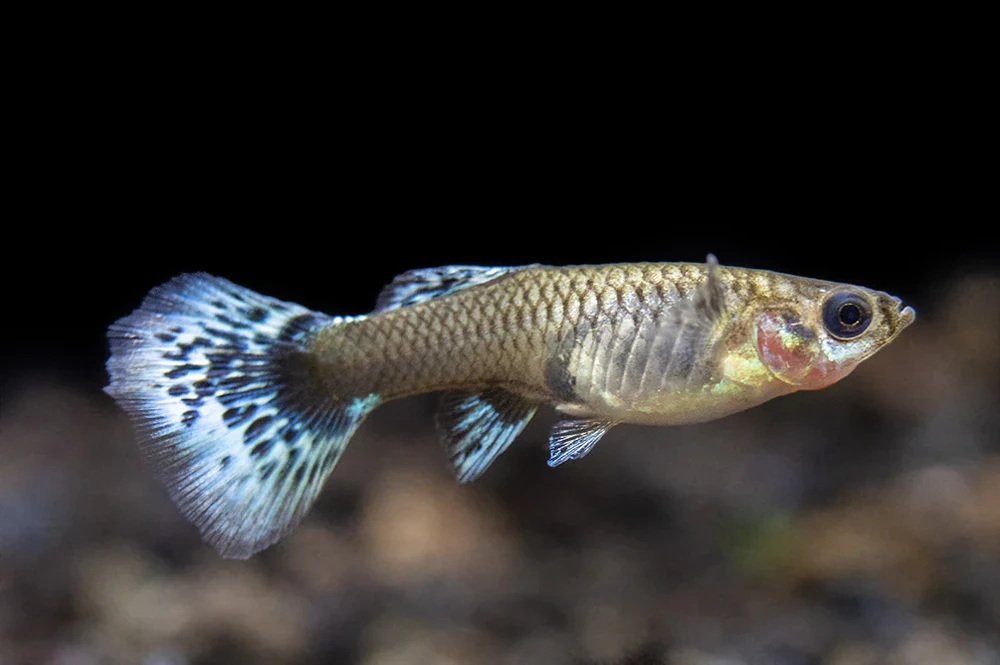
Pros and Cons
Pros
- Unbeatable variety of stunning colors and fin types.
- Extremely peaceful and excellent for community tanks.
- Very affordable to purchase and maintain.
- One of the easiest fish to breed, offering a fascinating hobby.
- Hardy and forgiving of minor fluctuations in water parameters.
- Do not require a very large aquarium.
Cons
- Prolific breeding can lead to overpopulation in a mixed-sex tank.
- Males will constantly pursue females, which can stress the females.
- Fancy fins make them targets for fin-nipping tank mates.
- Some modern strains can have weakened immune systems.
- Require stable, warm water and cannot live in unheated bowls.
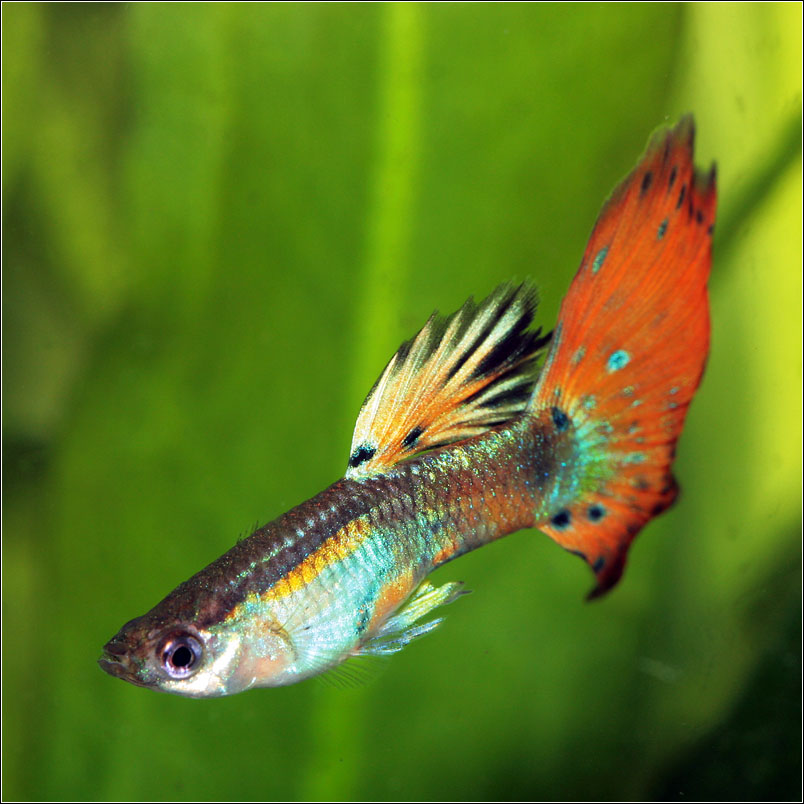
Final Thoughts
Guppies truly deserve their title as a king of the beginner aquarium. They offer a perfect blend of beauty, activity, and fascinating biology that can captivate a hobbyist for a lifetime. While their care is straightforward, it is not negligible; providing them with a properly sized, heated, and filtered tank is non-negotiable for their long-term health. The joy of watching a tank full of these glittering jewels, and potentially raising your own generations, is an incredibly rewarding experience.
If you are considering starting your first aquarium, we highly recommend beginning with a group of these charismatic fish. Their vibrant energy and dazzling displays will quickly show you why they have remained a cornerstone of the aquarium hobby for decades.
Have you had a memorable experience keeping or breeding guppies? We would love to hear your stories and see pictures of your fish in the comments below! Share your tips and triumphs with our community of aquatic enthusiasts.
For more detailed care guides on other aquarium fish and in-depth articles, stay tuned to our blog and remember to subscribe to our newsletter! 🐠

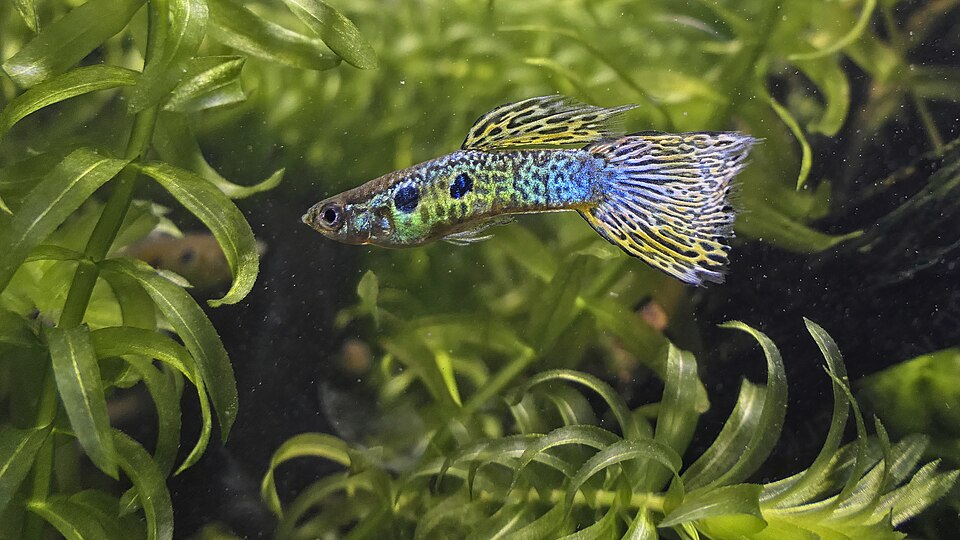




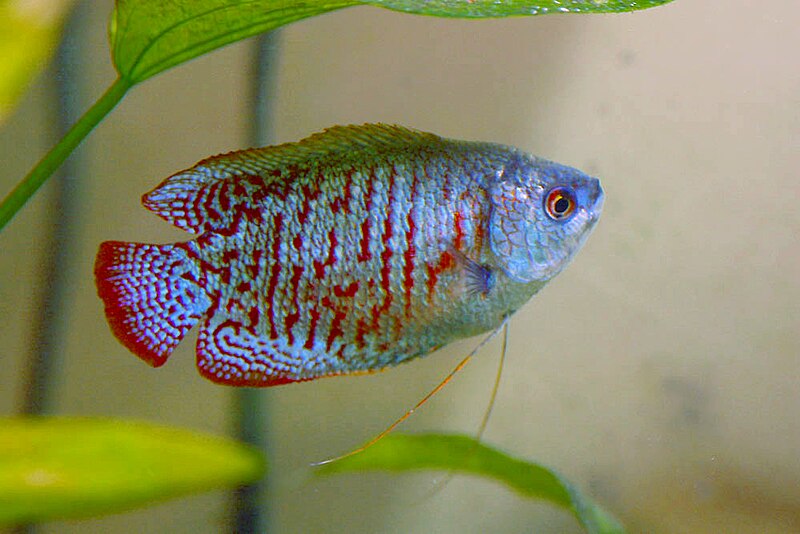
Leave a Reply